Roy Christopher's Blog, page 5
July 10, 2024
An Invisible Intellectual Speakeasy
Chase Griffin recently did an interview with me for Metapsychosis, a journal of consciousness, literature, and art. Chase is the author of What’s on the Menu? (Long Day Press, 2020), the forthcoming Peter Zoidoid & the Commonplace (Corona\Samizdat), as well as co-author (with Christina Quay) of How to Play a Necromancer’s Theremin (Maudlin House, 2023), about the latter of which I wrote,
“How do you like your metaphors mixed? This work of psy-fi docutainment, best ingested by first grinding it into Bookpowder, follows Rocco Atleby’s kudzu plots in the pursuit of fluctuation on the horizon of the Patasphere. Flitting and flirting with spacetimeconsciousness dimensionzzzzz, deep down, heinleined under there somewhere, Chase Griffin and Christina Quay have committed some really serious satire. So pack your pestle and mortar and get ripping!”
Thanks to Chase’s insightful questions, he and I cover quite a lot in this short but wide-ranging discussion.
Read on!
 Redfishingboat (Mick O), sk8 or fly [CC BY-NC 2.0]
Redfishingboat (Mick O), sk8 or fly [CC BY-NC 2.0]Chase Griffin: Is there a circuit for you between BMXing/skateboarding and media theory? If so, what’s that sparking thing?
Roy Christopher: Well, in the broadest sense, one of my main research interests is the influence of technology on culture. The study of media—and even that in my mind is quite broad—somewhat narrows the research to where the results of this collision play out. I’m focused on the domains of various youth cultures, so BMX and skateboarding media is where bikes, boards, digital cameras, video cameras, writing, riding, music, and the like converge and capture it all. When you watch a video or see a magazine from a certain era, you’re seeing a snapshot of a culture at that time.
So, yes. I started making zines in the summer of 1986. Ten years later, I started messing around with HTML, and I saw the web as another level in zine-making. Though I was still doing print zines, I learned some basic code, bought some domain names, and starting building websites. The blogs (a term I am still hesitant to own) of the 2000s might’ve been the last era during which I felt like my approach to indie discourse thrived. The social-media silos killed all of that.
CG: Is the feedback loop the only way to go? Is this what makes today’s media such an anxiety inducing place? It feels like it’s not just the geopolitics and climate change? The loops, content aside, can be wholly crippling for many. It feels conspiratorial at times, in a divide and conquer kind of way, to get us all to stop acting in meatspace and live in this anxiety box so that the robber-barons can go on robbing the poor and raping the earth. Is there an alternative to this? Is there a way to create a more positive media?
RC: Last year, I went back to a bar I used to frequent in Chicago, and the same few people were there, sitting in the same places, having the same conversations. That’s what social media looks like after you take a break. It’s always baffling to see the same people posting the same stuff months later.
So, my first inclination is retreat. I’ve left every major social media platform and flirted with a few new ones, but I get fed up and deactivate them every few weeks. It makes for an inconsistent online presence, but I can’t be more consistent with it and still feel human.
Anxiety is lucrative. Once the social media platforms saw the goldmine of outrage, their steering users toward anxiety of one sort or another was inevitable. This has spread to every other kind of media. The goals are not information or entertainment as much as they are to elicit a reaction—any reaction. It’s turned journalists into trolls and the rest of us into dupes. There’s just more money in making people feel shitty than there is in making them feel good.
Anxiety is lucrative… There’s just more money in making people feel shitty than there is in making them feel good.
CG: What is the best way to help others?
RC: Fund their creative pursuits. Every problem I see my artist and writer friends and colleagues having is because there’s no money to do the cool things they want to do. I have the same problems, but I’ve sacrificed things and adjusted my lifestyle to facilitate the creative work I want to do, and subsequently I get to do some of it. The internet democratized and simultaneously demonetized everything.
To put it simply in a slogan: pay for art.
CG: I feel like we should all get together and create a better media. I miss the promise of the user-generated utopia. Do you think coding and computer engineering should be taught in public school widespread and starting at an early age? Do you think that if everyone speaks the new Latin, we can jumpstart society and get along without the new greedy and incompetent priest class?
RC: I can’t help but be cynical about the state of media at this point. The promise of the user-generated world has been fulfilled, but it’s no utopia. Computers, the internet, and ubiquitous cameras and screens have democratized every form of creativity. If one can be a “content creator” simply by aiming a lens, we’re not exactly honoring human creativity. DJ Scratch once said that the reason we respect something as an art is because “it’s hard as fuck to do.” Is the bar getting higher or lower?
A lot of my current students have majors that you would think would help (e.g., computer science, data science, information science, etc.), but the truth is that not everyone should be doing this stuff. The barriers to entry that existed before the internet were not tuned properly, but take a quick look at your feed, and you’ll see that we need some of them.
I think it’s all going to get a lot worse before there’s even a chance of it getting better.
CG: What does your ideal virtual community look like?
RC: A real-life secret salon. An invisible, intellectual speakeasy. I know a lot of smart, creative people. If I had a place to meet all of them on a regular basis and exchange ideas and collaborate on projects, that would be the ideal virtual community. If you went looking, you’d never find us.

Many thanks to Chase Griffin for doing this interview, Metapsychosis for publishing it, and you for reading and sharing it.
Thank you,
-royc.
June 24, 2024
Translating Motion
The first pair of pegs I had on my bike were made for a motorcycle. They were bolt-on, fold-down foot pegs designed to be used for passengers. I bolted them on the fork legs of my Blue Max. They twisted around quite a bit, but if you were balanced just right, they’d hold you in place. This was before axle pegs were available in every bike shop, before bolt-on pegs and platforms, and well before flatland BMX became one half of competitive Freestyle BMX during the AFA years, less and less a part of it during the X-Games era, and then slid from the face of major competitive coverage, into solitary obscurity, away from the rest of BMX.
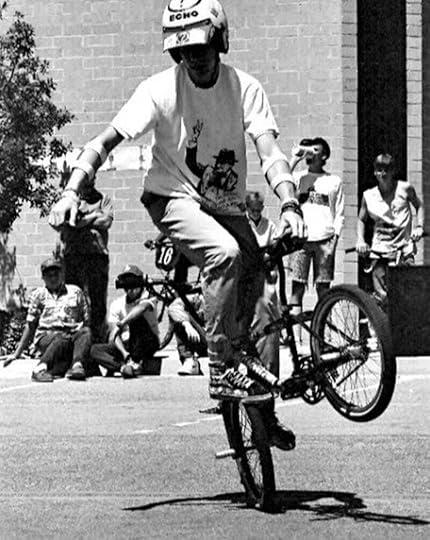 Me in a Funky Chicken position during a contest in Jacksonville, Florida in 1990.(Note the standing pegs.)
Me in a Funky Chicken position during a contest in Jacksonville, Florida in 1990.(Note the standing pegs.)When I was riding the Blue Max with the motorcycle pegs, there were only a handful of flatland tricks to learn, and it was easy to see where to start if you wanted to learn even the hardest of them. Curb endos, 180s, rollbacks—the core of the sport's repertoire didn’t even require pegs. This changed quickly as the sport progressed. By the late 1980s, there were hundreds of tricks, many of which involved rolling around in either direction on either wheel, and many of which I still can't do to this day.
Doing tricks on a bicycle is all about translating one kind of motion into another. Whether it’s rolling, spinning, balancing, or just standing somewhere different, every maneuver is about turning an expected movement into the unexpected stunt.
 Matt Heckert and his “Walk-and-Peck” machine.
Matt Heckert and his “Walk-and-Peck” machine.I was introduced to Matt Heckert’s work by issue #7 of Andy Jenkins’ Bend zine. There was a picture of Survival Research Laboratories‘ “Walk-and-Peck” machine (a.k.a “The Centaur”), and it was credited to Heckert. This was the Summer of 1986, just after W&P had a feature role in the SRL performance, “Extremely Cruel Practices: Designed to Instruct Those Interested in Policies That Correct or Punish.”
Now Heckert makes kinetic sound machines. Some are noisy as all hell. Some click, pop and convulse like mechanical, prehistoric creatures. All are fascinating both visually and sonically (See his “Birds” for one example).
“All of my work ends up sounding like a train somehow.” — Matt Heckert
The installation he built for the San Diego State University exhibition I saw involved tilting hoops that cause long poles to rotate in circles. The sound they generate is an ambient metal symphony of sorts. The six machines are connected to a computer where a MAX/MPS MIDI program controls their motion. The programming was done by Heckert’s friend William Tsun-yuk Tsu, and it’s set to randomize their motion so that the machines are all doing their own thing. Also programmed into the controls (at random intervals) is a sequence during which the machines all drop to their lowest speed, and one where they all go freaking-ape-shit-fast. Watching them all fall into sync at low gear after an hour or so of chaos is a calming, serene experience.
 Matt Heckert’s “Rotifiers” at SDSU in 2003. [photo by Roy Christopher]
Matt Heckert’s “Rotifiers” at SDSU in 2003. [photo by Roy Christopher]The installation was originally titled “Martian Cocktail Party” after an old composition from 1981 that Heckert did prior to forming his Mechanical Sound Orchestra. I suggested “Stirring Machines” due to the stirring motion of the poles and as a play on Alan Turing. With a smirk, Heckert said he’d add my suggestion to the list. He told me later via email, “It seems I have a propensity to pursue sounds from the roterior (i.e., sound from the process of rotating) and build things which allow for rotification of sound, so I would just as soon call these things ‘rotifiers.’” Having spent many hours in the room with this installation, I can say that it was a thing of odd beauty. Having dismantled the machines for their trip back to the Bay Area, I can say that their elegance betrays the complex inner workings of Heckert’s design.
In the artist’s statement for his Machine Sound Orchestra, he writes,
I found that when a mechanical device performs a repeated task by remote control, an observer tends to believe the device is somehow expressing some kind of autonomous emotion—frustration, desire, etc.—thus creating the mystique of an intelligent or sentient machine. This is not a sound issue, of course, but one which deals with the audience/performer relationship and the audience's perception that some sort of non-verbal communication is taking place.
During the reception at SDSU, I overheard Heckert telling another machine-sculpture artist that the trick was translating one kind of motion (e.g., a spinning axle) to another (e.g., a rotating ring), and I couldn’t help but think of riding my bike. Flatland BMX might not quite be an art form, but it toys with audience expectations in a similar way. The things we enjoy about watching technical extreme sports and kinetic artwork are not only the skills on display but the twists and tumbles we didn’t expect.
I still ride flatland, but the pegs on my bike these days were made for it.
 Get a Spine!
Get a Spine!I have a few books out, if you’re interested. :)
Bits of the above originally appeared on ESPN. Shout out to Brian Tunney. Thanks also to Matt Heckert and Andy Jenkins.
Thank you for reading, responding, subscribing and sharing,
-royc.
June 7, 2024
Capturing Collapse
Unlike other war movies, Alex Garland’s Civil War is told from the point of view of those behind the cameras. War photographers in search of the elusive moneyshot, Lee Smith (Kirsten Dunst) and Jessie Cullen (Cailee Spaeny), along with journalist Joel (Wagner Moura) take their quest all the way to the top. The film follows them from New York City to Washington DC–from war-torn city streets, through the free-for-all frontier law of rural areas, through the military frontline, all the way to the White House. As Sammy (Stephen McKinley Henderson) reminds them on the way, “It’s not a story if it never gets filed.”
 Kirsten Dunst and Cailee Spaeny in Civil War (2024).
Kirsten Dunst and Cailee Spaeny in Civil War (2024).The scariest part of the film isn’t the gunfire, explosions, death, or destruction. By far the film’s scariest feature is its ontological instability, the watching of one’s world crumbling with nothing in the way of recourse. The lack of cues from limited access to media heightens the sense of helplessness. The lack of partisan politics is part of the film’s power. There is precious little information about what will come next, which adds to the fear and anxiety of the journalists trying to capture the collapse.
There is a paradox here, a struggle between exposure and isolation: exposure to danger and isolation from information.
The camera work of the better found-footage films, like The Blair Witch Project (1999), Chronicle (2012), and Cloverfield (2008), which the latter’s director Matt Reeves likened to “looking through a soda straw,” is eerie and effective in a similar fashion. There’s such a sense of exposure. The first-person point of view makes the viewer feel “in” the movie, as opposed to passively watching it. The scariest moment of M. Night Shyamalan’s Signs (2002) was when the television stopped working. The sense of isolation inherent in that moment is terrifying, isolation from safety and exposure to hostility. Much like the security camera footage of the Columbine shootings, and the camera-as-character of Cloverfield, Garland gives us a crippled information flow (i.e., looking through view-finders, no media coverage) while subjecting us to total exposure (i.e., driving through a country in the throes of war).
Filmmakers are typically trying to get movie cameras “out of the way” of the movie. Filmmakers typically aim for the camera to be transparent, much as transparency has been advocated in computer interface design. Authors Jay Bolter and Diane Gromala have argued that the interface needs to be reflective as well as transparent, as in windows and mirrors and their book of the same name. The interface needs to get out of the way sometimes (transparency) and provide cues for interaction at other times (reflection). Moving images have similar needs to fulfill.
In Civil War, the cameras are so decidedly in the way as to become focal points. Snapshots pause on the screen as they are taken. Their wobbles, glitches, blurs, and unrelenting singularity of viewpoint define and redefine our experience in the film’s undulating chaos. In this way, Garland deftly mixes form and content, mention and use. The photographic process is integral to the picture.
Even if it’s far from grainy security camera footage, the camera’s limits are what define this viewing experience. Even in defying our expectations, it is a surprisingly effective film. Even with its focus on photography, in Civil War the best shot is all Garland’s.
A version of this review originally appeared on bOING-bOING. I expanded it here after seeing the movie a few more times. My favorite scene, which I didn’t get to talk about above, is just after the midpoint when, having just escaped a certain death (featuring the momentary but meme-worthy appearance of Jesse Plemons), the main characters are driving through a forest on fire. Burning embers float in the air around their truck as Sturgill Simpson’s “Breakers Roar” is playing. It’s such a beautifully brief respite from the chaos.
Also, Sturgill Simpson is only one of the many great artists on the soundtrack. Civil War also features songs by Can, Suicide, Silver Apples, and De La Soul, as well as the score by Garland’s regular collaborators, Geoff Barrow and Ben Salisbury.
Thanks for reading, responding, subscribing, and sharing,
-royc.
May 31, 2024
Arrival by Circle or Spiral
Lately I’ve been feeling envious of theatre and AV-club kids in high school and English majors in college. As I continually fill in the holes of my education and follow the expanding tangents of my curiosity, it feels like I’ve been playing catch-up with things I should've been paying attention to sooner.
I remember being out with a few friends in a parking lot in Seattle. We were all skateboarding curbs and riding BMX bikes in circles—all of us but one. I remember his saying, “In high school, when you guys were doing that, I guess I was in my room playing guitar.”
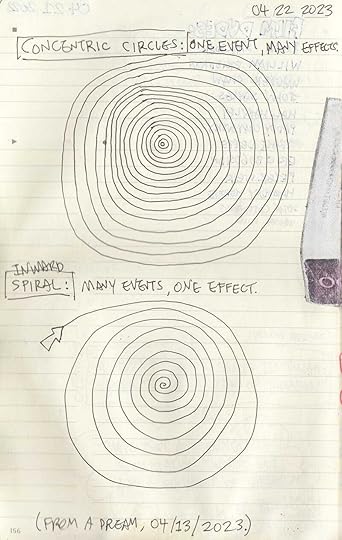 A diagram from a dream in one of my notebooks.
A diagram from a dream in one of my notebooks.I feel that now about the guitar players, but also the theatre and AV-club kids, as well as the English majors. I guess when they were learning scales, reciting Shakespeare, connecting RCA cables, and reading classics, I was out in the driveway on my bike or skateboard. Though I did dabble in other performing arts, it’s hard not to wonder what my path would look like had I taken to a different one or another instead of the ones I did. You can probably think of a few turns not taken yourself.
When I was in middle school, I attended a filmmaker’s workshop at Athens State College in Athens, Alabama. We—me and three other adolescents—made a short film called “Super Chicken and the Great Soccer Ball Caper.” A few easy camera tricks allowed the caped chicken (played by me, pictured below in the Athens News Courier) to disappear and reappear in different scenes. I popped in and out of a soccer game that was happening on campus and saved the ball somehow. I don’t really remember what little there was of a plot.
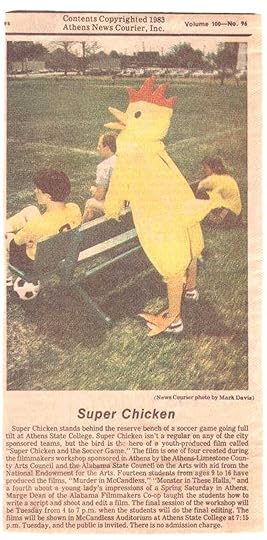 Me as Super Chicken in the Athens News Courier, 1983. My mom made the costume.
Me as Super Chicken in the Athens News Courier, 1983. My mom made the costume.I do remember the McCandless Auditorium where we edited and screened our films. It was a creepy old building and subsequently half of the amateur movies from our workshop were horror films (“Murder in McCandless” and “Monster in These Halls”). I also remember that I never really felt comfortable. I enjoyed working with film, coming up with the story, the shots, and blocking, but the teacher was kind of mean to us, and the parents all seemed vaguely unhappy with her. Now that my interest in film and filmmaking has taken on new significance, I wonder what would’ve happened had that workshop gone differently.
I don’t regret the hours I spent and continue to spend on my wheeled toys, but one can’t help but wonder about the decisions we’ve made, especially when it seems that our current pursuits could’ve been better served another way. Ten thousand hours is a long time. As True Detective’s Rustin Cohle says, “Life’s only long enough to get good at one thing. Just be careful what you get good at.”
Thank you for reading Roy Christopher. This post is public so feel free to share it.
Thank you for reading and sharing and swirling,
-royc.
May 21, 2024
The Medium Picture
I recently got an email celebrating the 21st anniversary of my long-abandoned LiveJournal account. I looked back at my six entries from 2002 and found the seeds of a book: my earliest research in media theory, a note on Brian Eno’s edge culture, the claustrophobia I felt from working on computer screens.
That was supposed to be my first book. I started outlining it in 2001, worked with an agent on it for a few years, and—after a decade of research and revision—I originally signed a contract for it in 2011. The book then went through several publishing shuffles, during which I went on to finish several other projects. I worked on it off and on in the meantime and am happy to finally have it on the way out of my head and into your hands.
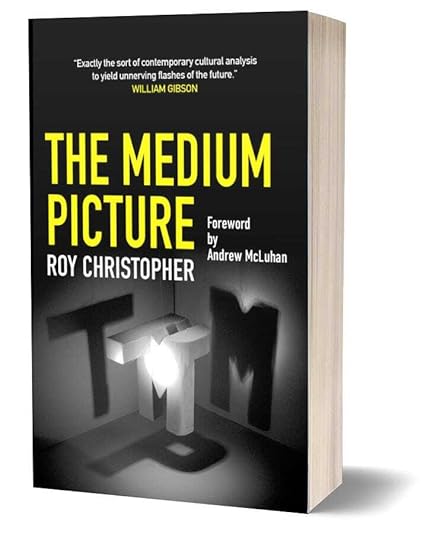 My mock cover for The Medium Picture.
My mock cover for The Medium Picture.To that end, I am proud to announce that the University of Georgia Press has deigned to publish The Medium Picture. To wit, I was born in Georgia, and I attended UGA briefly during my first attempt at grad school. This project is very close to my heart, and I am stoked to have the UGA Press putting it out.
Here is a brief overview:
The ever-evolving ways that we interact with each other, our world, and our selves through technology is a topic as worn as the devices we clutch and carry everyday. How did we get here? Drawing from the disciplines of media ecology and media archaeology, as well as bringing fresh perspectives from subcultures of music and skateboarding, The Medium Picture illuminates aspects of technological mediation that have been overlooked along the way. With a Foreword by Andrew McLuhan, it shows how immersion in unmoored technologies of connectivity finds us in a world of pure media and redefines who we are, how we are, and what we will be.
The book uses ideas from Marshall McLuhan, Brian Eno, and Mark Fisher, examples from Fugazi, Radiohead, Gang of Four, and Run the Jewels, and artists like Christian Marclay, Richard Long, and Laurie Anderson. It’s post-punk media-theory!
Here’s what some nice people are saying about it:
“Exactly the sort of contemporary cultural analysis to yield unnerving flashes of the future.” — William Gibson
“Like a skateboarder repurposing the utilitarian textures of the urban terrain for sport, Roy Christopher reclaims the content and technologies of the media environment as a landscape to be navigated and explored. The Medium Picture is both a highly personal yet revelatory chronicle of a decades-long encounter with mediated popular culture.” — Douglas Rushkoff
“A synthesis of theory and thesis, research and personal recollection, The Medium Picture is a work of rangy intelligence and wandering curiosity. Thought-provoking and a pleasure to read.” — Charles Yu
“Immersed in the contemporary digital culture he grew up with as a teenager, Roy Christopher is old enough to recall vinyl, punk, and zines — social media before TikTok and smartphones. The Medium Picture deftly illuminates the connections between post-punk music critique, the increasing virtualization of culture, the history of formal media theory, the liminal zones of analog vs digital, pop vs high culture, capitalism vs anarchy. It’s the kind of book that makes you stop and think and scribble in the margins.” — Howard Rheingold
I have a bunch of things planned for the rollout, but first…
After all of this time and all of the rejections, it feels really good to announce that The Medium Picture will be out next fall from the University of Georgia Press.
Thank you so much for reading, responding, and sharing.
Looking forward,
-royc.
May 9, 2024
Jenny Toomey: Fits and Starts
In November 1993, a few months after I first moved to Seattle, I went to see Washington, DC’s Tsunami at the late, legendary RKCNDY. It was a magical time in a magical place, and I was marveling as the names on record sleeves and magazine pages emerged in the flesh. At the merch table, I met Fontaine Toupes of Versus (who signed my Versus 7” “Seattle ain’t shit!”), my friend and collaborator to this day Tae Won Yu, as well as Kristen Thompson and Jenny Toomey of Tsunami and Simple Machines Records.
Toomey is a towering figure in 1990s punk rock, playing in bands, running a record label, and so much more. She and Kristen Thompson, put out The Introductory Mechanic’s Guide to Putting Out Records, Cassettes, and CDs [.pdf link], which was repeatedly updated with new and better resources over four editions throughout the 1990s. After releasing nearly 80 records, Simple Machines ceased operations in 1998.

In the meantime, Toomey has continued quietly trying to figure out how technology can serve music and musicians. She was the founding executive director of the Future of Music Coalition, and she worked in various roles at the Ford Foundation. She’s also working on a book about all of this stuff. In her recent op-ed piece for Fast Company, she recognizes a pattern repeating. Likening generative AI to the file-sharing wave of the early 2000s, she writes,
The potential bait and switch of the tech world today is worryingly reminiscent of the early 2000s. While new technology always promises a flashy quantum leap into utopia, it instead regularly delivers opaque systems that streamline mistakes from the past. Throughout 2023’s frenzied AI debates, my feelings of déjà vu have become undeniable.
After years working behind the scenes, Jenny Toomey is thankfully emerging again.
Roy Christopher: When the impact of the internet started to dismantle the music industry as we knew it, many touted it as a new DIY revolution, returning the means of production to the people. What did you see?
Jenny Toomey: I didn't see it flatly that way. In the same way that I didn't feel like punk rock solved the problem of consolidated corporate media. I mean, if you look back at the hippie movements, you can criticize some of the hippies as being sort of just hedonist utopic people in denial about the systems in the world and just rejecting them (drop out), and then you can think of other ones as pragmatic utopian people who say that if we’re going to live a different way, we have to model how to live that different way which is more “drop in” or Whole Earth Catalog or Our Bodies Ourselves or eventually DIY punk.
That’s the element of counter culture and punk that I really liked. Not the flashy nihilism of tearing the old down, but rather the joyful enthusiasm of building the new. Asking that increasingly unasked question, “Why are we consenting to so many things we don’t agree with? And what would it look like if we tried to build different systems to give us more and better choices?” So, putting out your own records is a piece of it. A nice piece… nothing wrong at all with putting out your own records, but it’s not going to solve the problem of highly concentrated corporate media systems in late-stage capitalism. It does offer you a way to not completely condone what you abhor. Simple Machines was very much about that… grasping at, or rebuilding a small patch of agency.
With Future of Music, it was a little bit more trying to bridge those two things, saying we’re actually at an inflection moment where the systems are going to change, and if we could model more open systems, more transparent systems, systems that artists had more say in the design of and more benefit from, then we might get both things. We might get to avoid the systems we hate while actually contributing to building new systems that we could love.
And for me, there was an idealism to it that came out of coming from DC and a kind of can-do quality, that kids that were my age that grew up in DC felt empowered—to DIY, to make your own thing. But we were also practical and pragmatic, because we’d done some of this before. When we put out The Guide to Putting Out Records, and we saw that it took on both of those problems at the same time. First, the guide let novices get on third base and be in charge of their own punk-rock destiny and put out their own records because we spelled out the recipe. But the advice and guidance in the guide wasn’t neutral, it embodied certain values. It looked across the scene and modeled better behavior and therefore it influenced how the scenes functioned. So, if a pressing plant was using bad vinyl, we wouldn’t recommend them, and if a distributor wasn’t paying independent labels, we would take them out of our recommended list of distributors, and if somebody like Barefoot Press was doing great work, we would enthusiastically promote them. It was a way of putting our thumb on the scale to amplify the kinds of behaviors and values and relationships and systems we wanted built.
RC: That was just the beginning though, right?
JT: Yeah, that’s what we were trying to do initially, before we started the Future of Music Coalition. We were just trying to figure out the best path forward for our own catalog. Kristin Thomson from SMR and Tsunami and I started the work as a project we called “The Machine,” which was basically a blog on Insound’s website that allowed us to share whatever we were learning about the music/tech space in real time. We would just sort of reflect on all of the different music distribution systems that were reaching out to Simple Machines as potential partners because there were like dozens of different companies that were all starting up. They all had different business models. Some would buy your copyright outright, and some would license it, and some would encrypt your music, some would stream, some would download. We had no clear idea which of these options were better or worse. So, a lot of what we were doing was trying to understand the trade-offs and make our best recommendations based on guidance from different experts that we ran into in our travels. Very often, once we’d published something, other experts would come forward and disagree with some aspects of what we’d written and that back-and-forth would allow us to refine our recommendations and make the information even better.
We thought, let’s just do this until we can figure out what we want to do with our own catalog. Because we had like 80 releases and we had no idea what to do with them. Ultimately the music tech bubble began to burst, companies began merging and going out of business and getting sued by the major labels and we realized that that the emerging system wasn’t solid enough for us to recommend any of these companies. That’s when we knew we needed to set up an advocacy group. We couldn’t just recommend a good and trustworthy company, because that company would be out of business in a few months. Everything was in flux. Instead we realized we needed to advocate for a set of systems.
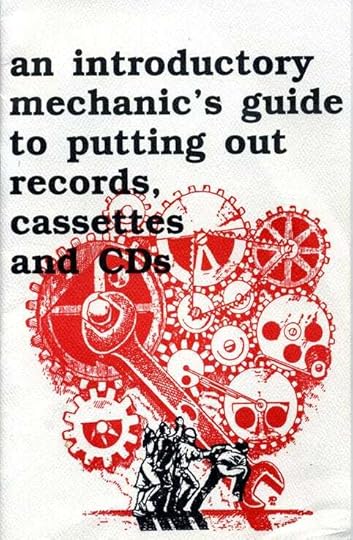
RC: That systems mindset is so important, zooming out enough to see the context of the changes you can and can’t influence.
JT: We believed that instead of just waiting around until everything was set in stone according to the desires of the most powerful companies, we could identify more artist-friendly systems we wanted to advocate for. That’s what it was about. And FMC served quite a useful purpose for a number of years, but then the bubble burst and the collapse of the marketplace put a lot of the idealists on their back foot and the concentration of control began to reestablish itself until it turned into the system we live with now.
It’s hard to remember the level of constant polarized propaganda that we live within now was once uncommon. Today controversial issues are sorted into a quick binary, and everybody finds themselves on one team or another in relation to most things. But that didn’t really exist back then. The internet started as a way to let a billion flowers bloom but ultimately played a starring role in fomenting that polarization. Just around the time that I left Future of Music. It felt like the copyright issues had become a total religious war. There was no discussion about the merits of the different opinions, and you were either on the team that were Luddites or you were artist-hating thieves. It was all caricatures, and in many cases the only ones who benefited from the public battles were the companies.
One of the main reasons I went to the Ford Foundation was to work on these questions at a systems level… I felt like we were not going to be able to build better systems if we were just focused on music. Music was the canary… It was the first industry where we could see the tech and society clashes, the trade-offs, the stakes. The systems that we were developing out of the music battles were on a path to impact all the other systems of journalism and publishing and film and democracy and everything else… as we’ve seen.
The systems that we were developing out of the music battles were on a path to impact all the other systems of journalism and publishing and film and democracy and everything else.
We forget that in the time before the internet there were public interest battles that led to rules that regulate newspapers, radio stations, TV…constraining the behavior of those who control the information pipelines. People fought to establish community-input requirements, ownership limits, and regulations to balance thought, constrain bias and propaganda. All sorts of rules and regulations existed for traditional media. But very few of those protections were extended clearly into the internet environment. Or if the rules did theoretically extend into this internet environment, it wasn’t clear how they would be enforced and by whom. So both the legacy media and the emerging tech companies went on the offensive and were able to use this moment of public disagreement and confusion as a fig leaf or fog behind which they successfully advocated for reduced regulation altogether. And that’s the world we’ve been growing accustomed to over the past 20 years. But it didn’t have to be this way.
Actually, the reason I started writing about music recently is because I feel like that same land-grab is happening all over again in the AI space. The optimism that I felt in the 90’s about the potential for the internet to transform society into a better place has disappeared and been subsumed into a kind of overwhelming powerlessness and pragmatic nihilism. An acceptance of how little protection we can expect from these surveillance and consumption systems that have basically threaded themselves through all of society. So, the piece I wrote for Fast Company was just trying to remind people of a time back when it was a smaller set of problems, focused on music. In retrospect it’s clear to me that we didn't have to make the choices we made, and we shouldn’t have trusted the companies on either side to protect us because it’s now absolutely clear that they exploited us. And maybe we can learn something from that.
RC: Here’s hoping!
JT: I think part of this problem is now everybody is so dependent on the tech systems that validate them with likes and attention we’ve all come to think of ourselves as a brand, and everything’s intermediated in that way. There is so much time spent on navigation and optimization… that somehow if we do everything right, two-factor authentication and just the right amount of self-promotion and other bootstrappy bullshit, we can win the rigged casino game. It’s very strange to me, but we also just assume these bad systems are the best we can possibly have and that they are permanent. They don’t have to be, but we’ve lost the outrage and the imagination that we’d need to remake them.
RC: That's one of the things you’ve been able to see very clearly, is that none of this is permanent. It’s going to change again.
JT: Right, right.
RC: There seems to be something fundamental about abandoning analog practices for their digital equivalents—or simulations thereof—that puts human authenticity in peril. Do you think that there’s a distinction there that's meaningful?
JT: Yeah. The vertical integration of everything and the co-mingling and codependence of information, creativity, community, labor and the systems of delivery, commerce and connection all through a self-dealing commercial gateway mostly designed by technologists who never took a humanities class… It’s disgusting and it’s obviously tremendously dangerous.
You and I are a bit older and technology was perceived in a completely different way when we were growing up. So, to give you a personal example, I very, very reluctantly took a typewriting class in junior high because I believed I was going to be a powerful woman who was never going to work as somebody else’s secretary. The association to typing back then was clerical. There was a status association to whether you did the “thinking work” or whether you did “technical work” supporting the thinkers. And in the 80’s women were still very often seen as the supporters and not the thinkers. So, as a feminist, I felt reluctant to even learn typing because typing was associated with a service role I didn’t see for myself.
When the internet came, that shifted dramatically. If you couldn’t type or understand the value of typing as the gateway into the internet you were gonna seem outdated and square. I remember my mother left a pretty powerful job running a large non-profit. When she was trying to get her next job she had grown fond of saying, “I don't even know how to type.” It was a badge of honor… a marker of her status as the type of woman who isn’t a secretary but who has a secretary. And I remember saying to her, “If you want to get your next job please don’t ever say that out loud again.” In the space of maybe five years “up” became “down”… and that’s just one example of how dramatic the shift was and how opaque and slow the cultural catch-up was for so many people, particularly my generation and those who were older.
RC: There are all of these invisible boundaries we find each other behind.
JT: When I went to Ford initially, that “othering” of tech was commonplace. Almost every single person who was recruited to run programs came from the academy, organizing, legal advocacy, policy advocacy—respected careers on the humanities side. Many of them carried with them bias-against, or incredulity or aversion-toward, tech as compared to the disciplines they studied and revered. This meant that they were incurious and had a gap in understanding just how thoroughly tech was transforming the landscape where they did their work. So, the smartest people, the ones with the power to stop it, sat back without contesting much of what the tech companies were doing till it was too late.
And it wasn’t until much, much later when I had a different role at Ford that we did research that allowed us to see that even the universities who were best prepared to graduate hybrid tech-experts, were actively siloing the tech away from the humanities. And we can all see how that turned out. So many of the clunky technical systems we are forced to use everyday (and live within) were designed by guys who were solving a technical problem on a deadline in a humanities-less void.
So, I think my major point is this one: We didn’t have to go into an environment where the internet was completely unregulated, because when you scratch the surface of the historic media rules—the rules that we have for telephones and the rules that we have for privacy and the rules that we have for equal opportunity and thousands of others—all of these rules should be enforced within the internet environment. But the advocates and the leaders who ran the nonprofits or the regulatory agencies that advocated for establishing and enforcing those historic rules were scared of tech, or functionally blind to tech. This meant that they functionally ceding enforcement. They back-burnered governance for long enough to normalize a digital world that lacks public protection. And while that was happening the tech companies became more powerful than the robber barons, and we all became complicit and dependent upon the systems they control.
RC: Is there a way out of that?
JT: There have been some moments of protest over the past 20 years, where artists have tried to demonstrate the value of their labor and their agency by saying, “I’m not going to be in your Spotify, or I’m going to build my own internet player that’s going to be artist controlled” or whatever. But in the meantime as the market becomes more streamlined and consolidated the stakes have become existential. The centralization of recommendation through the music players actually determines who can be seen as a legitimate artist and who is invisible. What’s worse, as the markets become integrated, how you are seen or “not seen” in those environments determines other things… whether you get enough attention to be paid any royalties whatsoever from Spotify… whether a venue will book your band without a certain number of likes or followers etc. We couldn’t even get a professional Spotify account for Tsunami if we didn’t have a Tsunami Instagram page to link it to. It’s way worse than I expected where all but the most powerful artists are forced to shop at the company store just to be in the game. And each post those artists reluctantly put out there to try to develop an audience is just more labor and content extracted to sell ads and train large language models, generating profits they will never share. So you go to Bandcamp to keep it real in the indie-sphere and that platform is actually owned by a Video game company and then they sell it… and you have to wait for the other shoe to drop… So, that just another reason to work with the largest companies that might not go away. Yuck.
I also wonder if that desire to be outsider and not self-promoting and secret is going to reestablish itself as a value in the same way that punk rockers said, I’m not going to look normal. I’m not going to sing pretty.
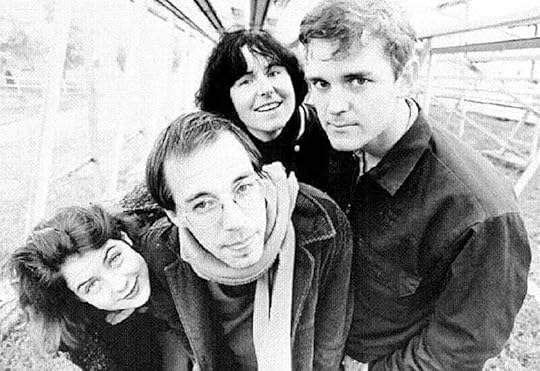 Tsunami: Jenny Toomey, John Pamer, Kristen Thompson, and Andrew Webster.
Tsunami: Jenny Toomey, John Pamer, Kristen Thompson, and Andrew Webster.Kristen Thompson, who ran Simple Machines with me, shared an album where all the song titles were in Morse code, which of course makes it impossible for any of the algorithms to recommend their songs. There’s no way that this was an accidental choice, and that kind of decision does seem a little bit like an art project or as like a way of getting a different kind of attention because it’s so different from a word where constant self-promotion is just a precondition of being a creator or getting a next job or whatever we have at this moment.
So, I really don't know how we disentangle those things. Maybe you don’t want to be on LinkedIn, but where do you get your next job? That's where everyone’s looking. Maybe you don’t want to self-promote on social media, but if you’re going to try to do a tour, more and more often the clubs determine who they book based on numbers of followers.
RC: You’re speaking my language now. These are all problems I’ve been having.
JT: It’s that centralization of attention. I don’t think it has to be that way. We could have chosen a different way or built different kinds of technologies that would’ve allowed us to maintain agency, privacy and diversity… lots of smaller pockets of success coexisting… and we would’ve had more competition in those environments, and we would've had accountability because they’d be fighting for your business. It sucks that for the last 20 years, the people who were in charge ignored technology, and then—in my book I talk about it like the stages of grief. There was a very long period of denial and then, you know, bargaining and rage and negotiating, but so many of them still haven’t gotten to the place of acceptance. And when you’re in acceptance, you’re like, “Okay, the world we were in before, it’s over. My partner is dead now. I can’t have another vacation with them. It’s over,” you know? And now I've accepted this, and I am in my next life and it’s sad… but acceptance means I can begin to build a real life because anyone that pretends we’re living in the previous world is in denial.
I don't know if that makes sense, but that’s certainly how I see it.
RC: Oh, it does… When I talked to Ian MacKaye, he mentioned the fact that punk was the last youth movement that used paper, which just struck me as such a brilliant insight that I'd never really thought about. He’s talking about zines and flyers and stuff. What do you think about that idea of paper being punk?
JT: I think paper contains the human gesture in a way that many forms of digital creativity does not. It almost always involves a greater level of scarcity. You could have the gesture of a human image or a human choice in someone who makes digital art, but it’s immediately replicable, you know? So, there’s not that scarcity in the same way—like people trying to create the artificial scarcity through the Bitcoin type stuff and those whatever they were called that everyone was talking about—
RC: NFTs?
JT: Yeah, but there’s something else about the pace of paper. It’s slower. Tsunami’s putting out a box set and Simple Machines putting out a box set with Numero, so I was forced to look at my archives. I have like 50 journals, and I had something like 17 suitcases packed with ephemera and letters—even before punk rock: I have a whole suitcase of all of my junior high school and high school correspondence, and it’s absolutely transformational.
RC: Absolutely.
JT: In almost all of the letters that I received in junior high school and high school people used fake silly names. They drew art on every envelope. They created collages. They were poets. There’s poems in there. There’s pictures in there. We were using every bit of our creativity to communicate with each other. And soooooo much time. These letters took hours. I can barely be bothered to write a full email these days or to listen to a voice message. Our level of attention is so fragile. It’s just destroyed. I had such deep attention, but everything is constantly distracting and pleasing us with little dopamine hits. We’re always jonesing now.
I also think that there was more of a barrier in some ways, too. There’s a privilege barrier. You had to have enough time to write all those letters, or the ability to cobble together a group house and enough part-time jobs that you had enough resources to be able to go on tour. So, when I think of how inexpensive it was to live when I was younger and how expensive it is now, it’s really shocking to me, but aside from that there was also a physical and time barrier to getting things out in the world. There were a lot of great bands that just didn't have the work ethic to put the 30 to 50 postcards together to send them out to the clubs to try to get shows, because that’s how we got our shows. You wouldn't waste money on a phone call. You sent a postcard to a club suggesting they might want to book your band without any ability to hear you at all.
RC: This is a whole other world.
JT: Part of what I really liked about working at Ford was we’re funding these brilliant visionaries who are getting the grants. They are the people who do the work, and they should have the platform and the attention to use their brilliant voices and it’s been a privilege to amplify those voices. But it also does mean that except in a few very specific forums, I've put my voice away for 16 years, and a part of that op-ed was also about beginning to think about, Well, what does Jenny’s voice sound like,16 years later?
RC: Exactly.
JT: That's why I'm trying to write a book as well, but it’s really hard to write a book. I don’t know how you wrote nine books.
RC: Well, I'm glad to help in any way that I can.
JT: I mean, what I should be doing is not an interview with you but writing. I'm supposed to be writing every day, and I get to do it a couple days a week.
RC: You and me both!
R.I.P., Steve Albini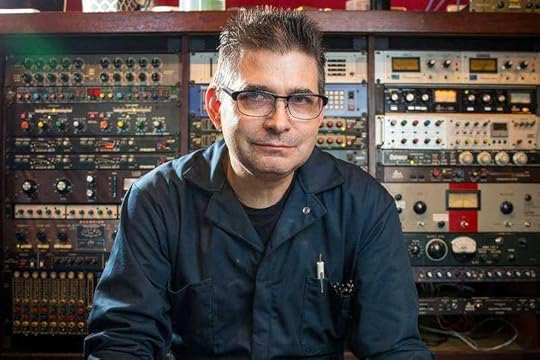
We lost a legend this week. Steve Albini has been a permanent fixture and an important figure in my world since high school—from Big Black to Rapeman to Shellac to all the bands he recorded. Though I had emailed with him sporadically over the years and lived within blocks of Electrical Audio in Chicago, I never met the man. Through close calls, mutual friends, and misconnections, I took his presence for granted. He had a potent, punk-rock attitude, a generous, gentle soul, and a razor-sharp wit. He was a purist among tourists. He will be madly missed.
I have a short list of people I want to outlive me. Albini wasn’t on it. I wasn’t expecting him to go any time soon. His passing is a great loss to Chicago, to music, and to the fight against the whole world’s slow slide into intolerable shit.
R.I.P., good sir. Keep giving them hell.
Many thanks to Jenny Toomey for her time and insight, and to you for reading and sharing,
-royc.
April 21, 2024
Metaphors Be With You
Figurative language is such a seamless part of our everyday communication that we forget it’s even there. Conceptual metaphors are so deeply engrained in the lattice of language we use that they both help us make sense of our realities and distort it beyond our understanding.
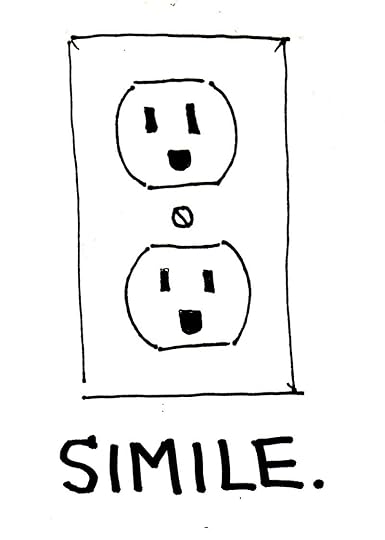
In their book Metaphors We Live By (University of Chicago Press, 1980), George Lakoff and Mark Turner have done probably the best job of outlining how comprehensively conceptual metaphors define our world (e.g., time is money, love is a transaction, up is good, down is bad, etc.). There is a point in the evolution of language where we acknowledge a new term or metaphor and that we’re using it, and then there is the space further afield, a “break boundary,” where the metaphor obsolesces into general usage. As Eugene Thacker tells me,
If metaphors are concepts that we forget are metaphors, then it seems important to remind ourselves of the tropic nature of such central concepts as the genetic “code.” Not only does this invite us to think otherwise (to think about alternative metaphors), but it is also an invitation to rethink the entire relation between metaphor and materiality itself.
If the explanatory power of the metaphor in use is successful, the metaphor becomes invisible. If a metaphor obsolesces into general usage, it is forgotten as a metaphor. As William Empson wrote, “Because metaphor, more or less far-fetched, more or less complicated, more or less take for granted (so as to be unconscious), is the normal mode of development of a language.”
Here are three alternative metaphors I’ve been thinking about lately.
1. Poisoning PeopleIt was once believed that the high achieved from eating psilocybin mushrooms was due to a poison. As the system processed and eliminated the poison, it produced the euphoric feelings mushrooms are known for. We now know that is not true, but the metaphor is a powerful one.
You know people who poison your circle, and when they’re around, social situations become largely a matter of metabolizing their energy; however, there is very rarely any high to enjoy.
 2. Latent Talents
2. Latent TalentsIn Cixin Liu’s 2018 science-fiction novel Ball Lightning, Dr. Chen and his military and scientist colleagues discover that ball lightning is created when lightning encounters “macro-electrons” in the air and supercharges them into the mysterious balls of energy. That is, the materials and conditions for the balls of energy exist in the atmosphere already, making them a product of activation rather than acquisition.
My rough paraphrasing and possibly inaccurate description of the phenomenon do nothing to blunt the power of the metaphor: A lot of what you want to learn or do or be is already evident in you. It doesn’t need to be acquired from the outside world, only activated from within.
3. Gaming the RulesI’m admittedly not a fan of ball sports, but I do enjoy a well-matched contest of any kind. Icing the kicker is a tactic in football whereby the defensive team calls a time-out just as the offense is kicking a field goal. It is designed to disrupt the flow and throw the kicker off his game. It strikes me as especially egregious because it has nothing to do with the skills involved in the sport. It’s a trick, a troll, and a frustrating way to see a team get ahead.
Call people out for trying to find such shortcuts, maintain your focus, and kick the ball as hard as you can. Stop looking for easy ways and excuses and just commit to getting good at the game, whatever the game may be. No one wins when everyone is trying to get around the rules, but everyone benefits from pursuing excellence, skills, and performance.
Language is powerful stuff, and the figurative is where we innovate. Metaphor, metonymy, simile, analogy, and allusion are only a few of the many tools available to explain our world when literal expressions fail. An effective metaphor—by explaining some previously unknown concept—renders itself obsolete and becomes a part of the larger language. Though it’s not always evident in the way we use these tools, the figurative is endless. We should all regularly explore new metaphor.
Thank you for reading,
-royc.
P.S. Apologies to Carrie Fisher from whom I stole the title of this post. R.I.P.
April 12, 2024
That Which Rolls
I’ve been riding bicycles—what the pataphysician, playwright, and avid cyclist Alfred Jarry called “That Which Rolls”—almost as long as I’ve been walking. I haven’t had a car since 1998, so bicycles have been my primary mode of transportation as an adult. Just after I built a new Big-Boy Bike a few years ago, a young friend asked me for some bike-building advice. I found myself qualifying my advice more than actually giving him any. I was trying to explain that I grew up riding BMX bikes, so I approach other builds from that background.
 Me and my Big-Boy Bike at Forsyth Park in Savannah, Georgia. [photo by my friend Peter Relic]
Me and my Big-Boy Bike at Forsyth Park in Savannah, Georgia. [photo by my friend Peter Relic]The friend in question was in his early twenties, and as I started explaining my involvement in BMX in the 1980s, I noticed his brow crinkling. He didn’t get it. The further I went, the more I realized that I was attempting to bridge a generation gap.
My bike-curious friend didn’t seem to believe that BMX could’ve been that big in my youth. During my competitive Freestyle (as BMX trick riding was called back then) days, I lived in Southeast Alabama. We had bike-shop-sponsored local contests every other weekend and regional ones monthly, as well as shows to do and the occasional national event thanks to the AFA (American Freestyle Association). From the early-to-mid-1980s to the early 1990s BMX was hectic: My age class in those national contests often boasted well over a hundred entrants. One thing I tried to explain to my friend was that though we played video games (e.g., Atari, Nintendo, arcade games, etc.), riding one’s bike was still way more exciting. Our hands were far more likely to be found on BMX grips than joysticks.
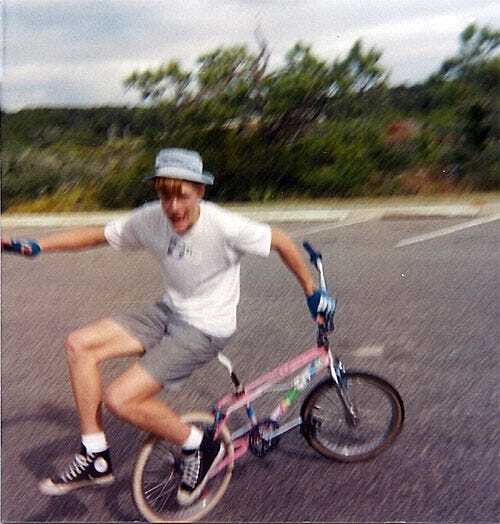 The author kicking a blurry backwards infinity roll sometime in the late 1980s.
The author kicking a blurry backwards infinity roll sometime in the late 1980s.Therein lies the first major difference: The experience of a BMXer today is much more likely to be mediated by technology than it was during any previous era. Given the proliferation of technology into every aspect of our lives, that’s not much of an insight, but in addition to the lack of distractingly immersive video games, the riders of thirty years ago were also missing out on the parks. There were like three ride-able skate parks in the whole country. Now there are at least that many in every city of any size whatsoever. Where the past was spent riding curb cuts, banks, walls, streets, and backyard ramps, today the terrain consists of those as well as many human-made options. It makes for different bikes, different riding, different tricks, and different values.
Flatland used to be one-half of Freestyle BMX. Now it is obscured out-of-sight in parking structures and flat driveways. Its intricate moves and flowing connections do not translate to television coverage. The pedestrian spectator nor the beginning rider are able to tell the difference between difficult and impossible (I covered this more thoroughly years ago in a story for ESPN). The same can be said for other kinds of riding: flow and style are less valued than the big trick. One huge trick at the X-Games can make a career.
Riders still go looking for street spots and terrain to tackle, but back in the day—aside from backyard raps and plywood propped up on bricks—that’s all there was. The spread of skateparks changed not only the scarcity of spots, but the spread of information about those spots. Having a central place to meet and exchange ideas changes the dynamics of a local scene thereby affecting overall progression of the sport.
With that said, nothing has changed the collective knowledge of BMXers more than mobile technologies. Before cellphones, cameraphones, iPhones, smaller and smaller digital cameras and video cameras, and even the web, riders relied on a handful of magazines and zines to keep up on what was happening: new companies and products, who was riding for whom, and—more importantly—who was doing what new tricks. An individual or crew in some remote enclave could be light years ahead of the overall curve of the sport and no one would know. For example, when Kevin Jones burst onto the flatland scene in the late 1980s, it was due in part to his appearances at national AFA contests which were covered by the major magazines, but knowledge of Kevin’s progression was largely spread through the mail by zines and videotapes. Hiding such talent is much more difficult now—even if you try. Can you imagine Mat Hoffman’s Highest Air Ever happening in total obscurity today?
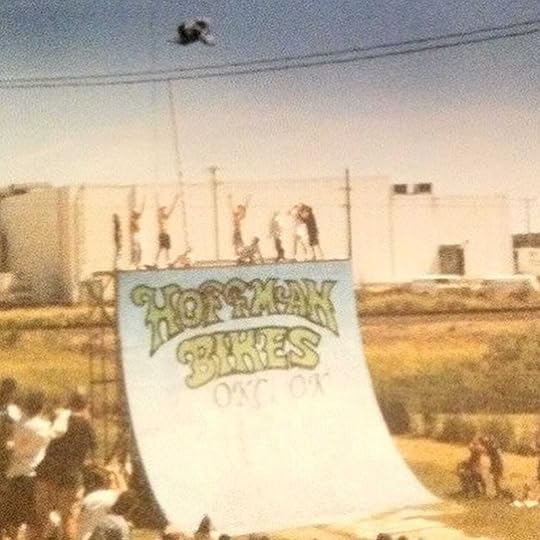 Mat Hoffman high in the haze, 1991.
Mat Hoffman high in the haze, 1991.Mobile media can make one famous. Like the X-Games, one huge trick—or one huge crash—captured on camera and immediately distributed online might not make a career, but it can make someone an instant star.
As always, thank you for reading, responding, and sharing,
-royc.
April 2, 2024
John Oakes: The Fast and the Curious
Constraints—self-imposed or otherwise—can be a powerful tool. I have argued in the past the merits of pulling back, but John Oakes’ new book, The Fast: The History, Science, Philosophy, and Promise of Doing Without (Avid Reader Press, 2024), digs deeper into the history of abstinence of all kinds than I’ve ever dared. It’s erudite and well researched yet highly readable, historical and thorough without being unnecessarily verbose, and instructional and inspiring without the inherent condescension of a self-help manual.
John has been a friend and a supporter of my work for years now, so it’s an honor to turn it around and talk about his here.
 John Oakes reading from The Fast. [photo by Gordon A. Gilbert Jr.]
John Oakes reading from The Fast. [photo by Gordon A. Gilbert Jr.]Roy Christopher: You found an angle that cuts across so many other concerns. How did you arrive at fasting as the topic for this book?
John Oakes: It was something I fell into. Post-Trump—or what I thought was post-Trump—I decided to do an intense fast as a curative. A long shower wasn’t enough, celebrating wasn't enough, meditation didn't work... I needed to purge myself. A long fast seemed just the ticket, and it more or less was. And during a long fast (this was a week) you find you have a lot of free time, not buying/not preparing/not cooking food. I became curious about what was happening to my body—around Day Three or so you begin to feel a bit stoned, because of the various chemicals coursing through your body—and I searched for details. And then I started thinking about the role of fasting in religions, philosophy, and politics. The entire concept of pulling back appeals to me—and there wasn't a book out there that combines these concepts. There are precisely a zillion how-to books on fasting that tell you it will cure everything from depression to old age, and a handful of academic books that look at aspects of the practice, but nothing that brought it all together. Plus, I like the idea of bringing a political perspective (the hunger strike and boycotts) to the discussion. Fasting has been integral to various political movements, from Russian civil rights activists in the 19th century, to suffragists and suffragettes, Irish and Indian patriots in the 20th century, to eco-activists in the 21st. Africans in the Middle Passage went on hunger strikes on such a regular basis that an instrument known as the speculum oris came into use by slavers to ensure force-feeding.
RC: Is there an underlying statement or message in The Fast that fasting is the path to?
JO: I would prefer to think I am simply reporting on the phenomenon and its spinoffs. BUT if pressed, I would say that fasting has so many applications beyond the religious or body-centric themes with which we are familiar. Judicious fasting can empower even those of us who are areligious and not body-obsessed. And it has been around a long, long time. It is for me a path to self-acceptance, to better understanding my place in the world, and it is a path that never ends. It is an important practice and it seems to me an effective one from a political standpoint. Even if hunger strikers don't win their cause, they almost invariably force a dialogue—authorities may brutalize hunger strikers (thereby revealing their corruption), media may report on the situation, bringing outside attention to bear.

RC: I’ve found a lot of personal growth in going without things. I haven’t eaten meat since 1994, haven't owned a car since 1998, haven't had any alcohol since 2017, never owned a television... What is it about going without that is so powerful yet untapped by so many people?
JO: Good for you, Roy! That succession of “going withouts” is going against the grain for sure, and I find that admirable. I think we give ourselves a sub-conscious pat on the back when we refrain from doing certain somethings that we know we could do, that we know we have the right to do. (Of course, that doesn't apply to all obligations; if, for example, we are supposed to pick up a child from school and decide not to do that, we are going to feel guilty.) Going without (to a limited degree) gives us strength because we suddenly realize we are stronger than we realize--whether it's something as profound as resisting making a cutting remark or as trivial as eating an extra slice of pizza that we don't really need. And yes, the nature of social media, with its lightning-quick responses, is anti-fasting. On social media, we're swept along by our reactions (even if we don't post) or our desire for reactions, and (with the help of corporations) we deceive ourselves into thinking we're expressing individuality.
RC: Fasting in particular and doing without in general are not always seen as rebellious or revolutionary, yet they are the simplest means of undermining oppressors, manipulators, and the system at large.
JO: To me, abstention can indeed be revolutionary, but I am not sure how simple that act is. The act of withdrawal threatens the system—any system—which depends on participation. If, for example, you are a prisoner, you are expected to play the role of a prisoner; a businessperson or consumer, the role of a businessperson or consumer, etc. If you undertake a hunger strike (in the case of a prisoner) or a boycott (in the case of a businessperson or consumer) the act of withdrawal—fasting from food in one case and fasting from contact in another—becomes a powerful tool, even a weapon. The ancient Irish weren't wrong to respect the power of fasting—“illegal fasting” even merited a fine in pre-Christian Ireland. Nothing terrifies Israel as much as BDS. But it is very hard to force people not to fast, or to boycott.
RC: You fasted yourself while writing this book. Have you done any form of fasting since finishing it?
JO: Indeed I have—in fact, at this moment I am on Day Five of a weeklong liquid-only fast. I fast for at least a week, twice a year, once in spring and once in the fall. It is my own personal ritual to assure the change of seasons!
—
The Fast is available wherever you buy books.
Thank you for reading,
-royc.
March 28, 2024
Photocopy and Find Out
Skateboard and BMX zines defined my formative years. Those handmade, photocopied publications were our network of news, stories, interviews, events, art, and pictures. It’s very difficult to describe how an outmoded phenomena like that worked once such epochal technological change, one that uproots and supplants its cultural practices (i.e., the internet), has occurred. FREESTYLIN’ Magazine’s reunion book, Generation F (Endo Publishing, 2008; flip through it at the link), has a chapter called “The Xerox was Our X-Box,” and that title gets at the import of these things. As I said in that very chapter, “Making a zine was always having something to send someone that showed them what you could do, what you were up to, and what you were into. Ours was the pre-web BMX network.”
 A small sample of my zines over the years.
A small sample of my zines over the years.At best, zines represent a hidden circuit of media, a grassroots exchange of information and ideas that slips through the cracks of popular culture. Zines are power in the hands of the fans. As Mark Lewman, editor of FREESTYLIN’ Magazine and head of Club Homeboy, as well as “Chariot of the Ninja” zine, points out, “The first zine I did once I moved to California was called ‘Homeboy’. I did one issue and some stickers, and it ballooned into a mail-order lifestyle company with 15,000 members, and became one of the first youth culture magazines, a pastiche of art and sport and randomness. So, the power of zines is pretty unlimited as far as I can tell.”
In spite of the proliferation of the internet, zines are not entirely a thing of the past. Every time we do something on our own instead of just taking what’s given to us, we strike a blow to the massive media machine that constantly shoves products and personality down our throats. Making your own zine is not only immeasurably rewarding (ask anyone who’s ever done one), but it gets your point of view out there and incites dialog between readers, riders and other zine-makers that wouldn’t necessarily take place.
Independent journalists wield the power to expose local underground talent as well. There were always obscure riders in sporadic locales ripping like top pros. There are always great bands no one has heard. The way to get them noticed was not to bug out about major magazines’ lack of attention, but to give the magazines a reason to pay attention. As ex-editor of Faction BMX Magazine John Paul Rogers puts it, “Quit bitching and get off your ass and do something about it.”
So, though they’re as much a part of the process anymore, I cannot overstate the importance of the experience of trading and making zines. There’s something to the physicality of the pages in your hand and the focus on those pages that pixels on screens don’t afford. As I said in FREESTYLIN’ Generation F, “Those first issues were the first steps on a path I still follow.”
Still true.
Portable Document Formats: My Daniel Menche interview from wow&flutter.
My Daniel Menche interview from wow&flutter.If you’re interested, I scanned and uploaded a couple of my later zines as .pdfs. wow&flutter (1997) was an attempt to bring together experimental noise of all kinds and featured interviews with Daniel Menche, John Duncan, and a cover story about turntablism. It was intended as part of a series, but the second issue, attack&decay, featuring interviews with Jack Dangers of Meat Beat Manifesto and Warren Defever of His Name is Alive, among others, never made it to press. I still love the idea of noise and hip-hop coming together, and there are others who’ve merged them in the meantime better than I could have imagined (e.g., dälek, clipping., Ho99o9, Death Grips, Cloaks, Justin Broadrick and Kevin Martin, et al.)
 A spread from HEADTUBE featuring Leif Valin. [layout by me.]
A spread from HEADTUBE featuring Leif Valin. [layout by me.]HEADTUBE (2001) was my attempt to return to BMX zine-making while maintaining my other, newfound interests in the early 00s. Though I maintained the website for years after, the zine ended up as another one-off print publication. It features interviews with Seattle ripper Steve Machuga, flatland guru Leif Valin, and the band Milemarker, as well as reviews of books, records, and other media. I still have a few copies of the print version. Let me know if you’re interested.
 The pilot issue of discontents and the long-arm stapler: a zine-making essential.
The pilot issue of discontents and the long-arm stapler: a zine-making essential.Oh, and if you missed the pilot issue of discontents, the latest zine I worked on with my friends Patrick Barber and Craig Gates, we’re working on a proper debut issue. More on that soon!
Thank you for reading, responding, and sharing,
-royc.



